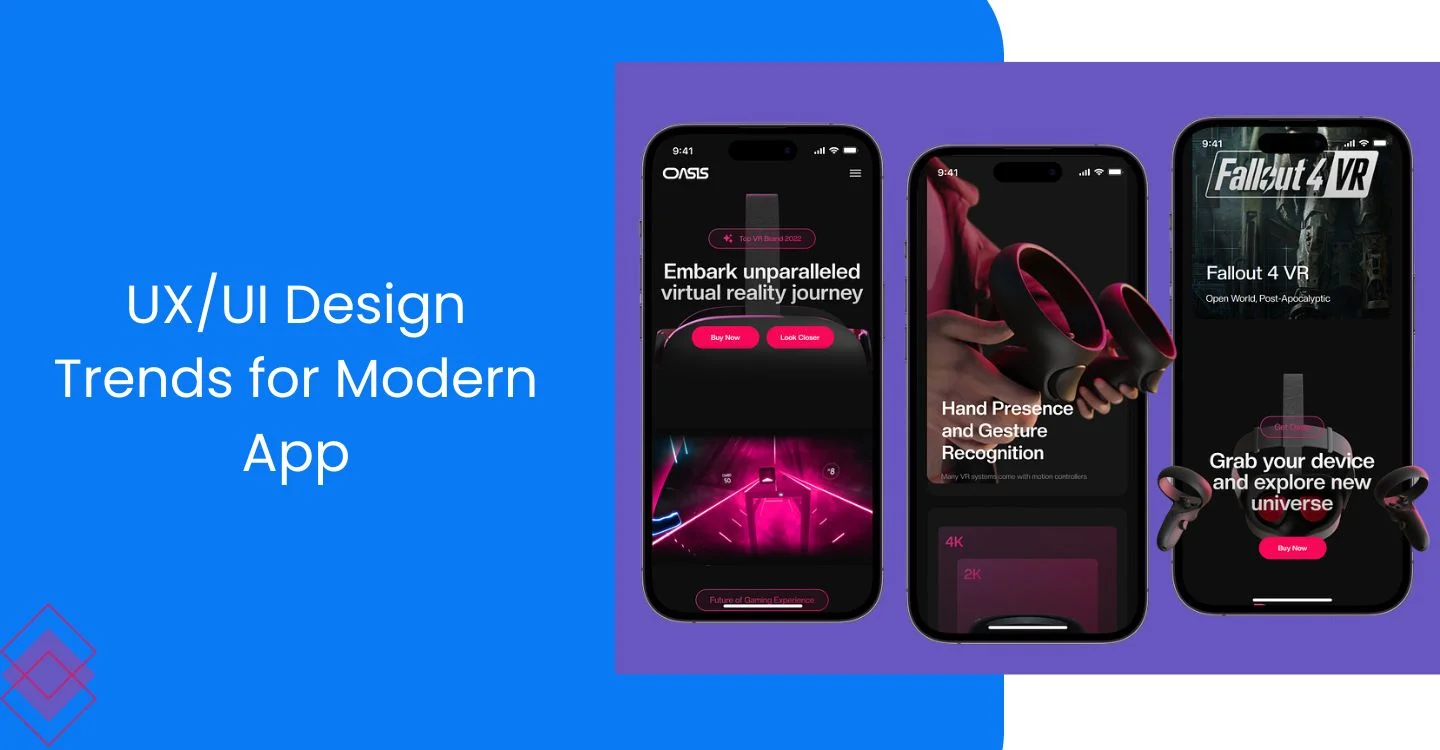Importance of UX/UI Design in Modern App Development
Today is the world of apps, and no matter what they’re about, they play a crucial role in growing your business in several ways. So, keeping up with the UX/UI trends is a must. We can say this based on a report from 2021: there are approximately 4.48 million apps available for download on various app stores.

UX/UI design is a kind of magic that shapes how users perceive your app. If the app is not very complicated, is easy to use, and makes people smile, then that is known as UX. It creates a path for users to follow, so they like each step of the way.
On the other hand, UI is the voice of the artist. It means that the app appears and makes sense. Combining the latest UX trends and UI is the most versatile combination that keeps the user happy and makes the app look like a star.
There is so much that is dependent upon the UX/UI design trend of 2023, like accessibility, simplified navigation, and anticipating the needs of the user to successfully acquire the goal with the app. The app is successful when users don’t have to get frustrated, promotes brand loyalty, and encourages positive word-of-mouth recommendations.
Moreover, the current market is competitive, which is visually attractive and has a user-centric approach, contributing to an increase in the number of downloads and long usage.
The Rapid Evolution of UX/UI Design Trends and Technologies
UX/UI design trends are evolving at a rapid speed, and it’s similar to the superfast dance of new ideas. What seemed so cool yesterday is normal in the current scenario.
Wear glasses that make you feel like you’re in a movie or game. That is what augmented reality (AR) and virtual reality (VR) do: they make things super real. Elements like colors, font, and how things move on the screen constantly change as the artist always seeks something new to make the stuff look cool.
So, when you use an app or website, understand that the UX/UI designer is like a wizard and appears amazing, as the design world keeps changing fast. You can think of it this way: every device works like magic, and in computer systems, all credit goes to AI. Designers employ this information and make things even better. Designers make sure that each new thing follows the rules and helps people.
The Fundamentals of UX/UI Design
A. Differentiating between UX (User Experience) and UI (User Interface)
User Experience (UX) refers to a user’s overall experience while interacting with a product, service, or system. It includes emotional, psychological, and practical aspects of that experience. UX designers focus on understanding the user’s needs, behaviors, and motivations to build a seamless and pleasurable journey.
They consider factors like ease of use, efficiency, accessibility, and the complete appearance the user can grasp. UX design aims to show that the user’s purposes are fulfilled in the most effective and enjoyable way possible.
On the other hand, the user interface, or UI, deals with the visuals and interactive elements of the product design. It is all about the layout, visuals, buttons, forms, and other additional interactive elements.
UI is responsible for developing an aesthetically user-friendly interface that aligns with the brand identity. Designers focus on schemes, typography, spacing, and the organization of the elements on the screen to ensure a visually appealing and coherent design.
B. The Significance of User-Centered Design
User-centered design means making an aesthetically pleasing website that people will love to spend their time on. It means thinking about the people want to see while you design a website. It’s that making people consider while solving a big puzzle, ensures that everything fits them perfectly.
When you take into account this approach, then it will ultimately make people happy and makes your creation successful. Here’s why user-centered design is so significant:
- Enhanced User Satisfaction: By considering people as part of your creation procedure, you prioritize their expectations, leading to higher user satisfaction and engagement.
- Improved Usability: User-centric design concentrates on creating intuitive interfaces and experiences, making the creation easy to use and lessening the learning curve.
- Effective Problem Solving: By becoming aware of designers’ pain points and challenges, develop a solution that directly addresses actual problems.
- Reduce Costs and Iterations: User-centric design soon discovers the flaw, lessening the need for costly revisions.
- Increased Adoption: When a product is served as per the preference, the user is most likely to adopt and suggest them to others.
- User Loyalty: The favorable user experience trends lead to user loyalty and prolonged relationship that benefits both user and businesses.
- Minimum Risk: User-centered design lessens the risk of developing products that fail to meet user needs or expectations, leading to better market reception.
Key Principles of Effective UX/UI Design
When it is about creating an awesome user experience (UX) and User Interface (UI), several key principles should be considered. Let’s meet them one by one:
- Clarity is supreme: Keep everything crystal clear. Users shouldn’t face any hassle finding out what your application or website is about. You must use straight language and intuitive icons to guide the user through the experience.
- Simplicity is king: Less is always more. You must simplify your design by concentrating on the necessary elements.
- Understand your user: You are not designing it for yourself but for users. You must consider their need and what they like. Try to create a persona to represent different user types and customize your design.
- Consistency is key: You must keep in mind that consistency never breaks and it should be in flow throughout your design. Follow the same style guide that leads to no confusion.
- User-friendly navigation: Your design is a kind of roadmap. Users must find what they’re actually looking out for. Logical menus, clear labels, and search options provide seamless and smooth user experience trends.
- Mobile-centric: Today’s world is mobile, and you must see if your design is different devices friendly and screen sizes. Definitely, responsiveness plays a vital role.
- Readability is a must: Fonts that look cool should be used, but if the user finds it hard to read, it’s a no-go. Go for a simple font that is easy to read, fine size, and has enough contrast between the background color and text.
- Quick Loading Speed: Patience doesn’t exist in the virtual world. Make sure that your design loads quickly. Compress your images, minimize the code, and performance optimization that keeps your user engaged.
Current Landscape of UX/UI Design Trends
A. Minimalism and Simplicity
- Importance of clean and clutter-free interfaces: Clean and clutter-free interfaces are the holy grail of user experience. It guides the user and reduces confusion and frustration. With simplicity, content shines, making it simple for users to find it effortlessly.

- Examples of apps that excel in minimalistic design: If we see Instagram, then it shines with a simple design that focuses on sharing images with clean lines and easy navigation. Google search app also stands out, which offers a clutter-free interface that delivers quick and accurate results. Simplicity masters in the app, proving that less is more.
B. Dark Mode and Color Schemes
- Benefits of dark mode for user comfort and battery life: The dark mode seems so cool but is also user-friendly. It lessens the eye strain, especially in dull environments, also, it saves the battery life on devices with OLED screens.

- Selecting appropriate color schemes for different app contexts: Selecting the right color palette is like choosing the exact outfit for the app. Warm tones give a feel of coziness, whereas bright colors scream energy.
C. Micro Interactions and Animations
- Enhancing user engagement through subtle animations: Micro-interactions are a kind of little surprise that keep engaging users. Suppose a heart icon subtly changes colors when tapped. Animation makes your app and site lively also dynamic.

- Examples of micro-interactions that improve user experience: When you move your mouse over a button or icon, and it changes its color is called a mini celebration. These are the small actions that seem big, but they make using websites or apps more fun.
D. Augmented Reality (AR) and Virtual Reality (VR) Integration
- Exploring the potential of AR/VR in-app interfaces : Augmented Reality (AR) and Virtual Reality (VR) are revolutionizing app interfaces, transforming with digital content. In the App interface, AR can empower users to visualize the product, like trying on virtual clothes or eyeglasses on yourself before purchasing it. This new innovation changes the way how we look at an app.

- Case studies of successful AR/VR integration in apps: Take Snapchat into account, Snapchat has brilliantly integrated AR in such a cool way by giving filters that turn users into different characters or animals. Such filters not only give a user fun but also make them laugh.
4. Conclusion
So it is a fascinating ride through the world of modern app development and UX/UI trends. It is a magic maker that shapes how we experience and interact with the apps. They perfectly blend user-friendly paths (UX) and captivating visuals (UI).
Crafting an intuitive interface for the modern app includes simplicity and elegance that comes from dark mode and playful elements of micro-interactions. It’s about creating an interface that users will love.
Also, we can never forget AR and VR that inject innovation into the mix. It’s more like giving users the experience that will lead them to keep engaging with the app or the website. We navigate the landscape of dominance of minimalism’s elegance that allure the dark mode comfort with the micro-interaction engaging touch.
The next time you get impressed by how everything seems clear or how the colors and fonts feel good to the eyes, remember that it is the result of the careful artistry of wizards. It’s the magic that keeps changing, like constantly evolving the dance of design trends.
Contact Nextupgrad for crafting an intuitive interface for modern mobile Apps!



![Read more about the article Swift vs. Objective-C [Updated 2024]:A Comparison Guide](https://nextupgrad.com/wp-content/uploads/2023/11/Swift-vs.-Objective-C-300x156.webp)
